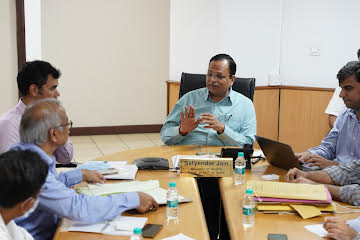Delhi Government is planning to install Reverse Osmosis (RO) plants in areas where groundwater levels are shallow but not usable due to high salinity, hardness and high total dissolved solids (TDS). Water Minister and Chairman of Delhi Jal Board (DJB) Satyendar Jain, convened a meeting with the DJB officials and took stock of the preparations. In typical RO systems, a lot of water is wasted during the purification process. However, Delhi Government will use RO systems that will be made from state-of-the-art technology which will have 80% of the water recovery rate. In the first phase, RO plants with a total capacity of 363 Million Litres per day (MLD) will be installed at strategic points where surplus groundwater is available. Raw water will be supplied from the groundwater in these RO plants, after which purified water will be supplied to the households. Delhi Government is targeting to install these RO plants only in those areas where surplus groundwater is available but its poor quality makes it unfit for use. For instance, water in the Najafgarh area is available just at the depth of 2-3 metres, however, it is high in salinity. Okhla, Dwarka, Nilothi-Nangloi, Chilla and Najafgarh will be targeted in the first phase of this project. The project is aimed to be completed within 1 year.
According to the Central Ground Water Board report, Delhi’s groundwater has over 22 Lakhs Million Gallons Litres of saline water. This water can be converted to drinking water after RO treatment and can be supplied with the existing water supply of DJB. The locations of projects are strategically selected so that the existing conveyance system can be used, which will save the huge cost of laying pipelines. To make the project cost-effective, Delhi Government will be following a model of staggered payment where the private investors will bear a major share of expenditure of setting up the RO plant and DJB will buy clean drinking water at a fixed rate. Based on initial studies done by DJB officials, the cost of water, in this case, will be equal to the existing cost of water treatment through conventional means. The Water Minister instructed the officials to shortlist the most advanced technology of RO systems available with at least an 80% recovery rate. RO wastage will also be disposed of in an environment-friendly way.
The desired output to be targeted is 363 MLD that will be achieved from Okhla, Dwarka, Nilothi-Nangloi, Chilla and Najafgarh. The project is aimed to be completed within 1 year. Satyendar Jain instructed the officials to find innovative mechanisms to make the project cost-effective. He also instructed the officials to install small RO plants in the areas where water is supplied through tankers, so that people don’t have to wait for water tankers to arrive. One small RO plant will be installed for every 500 households so that drinking water is available round the clock. Additionally, every Jhuggi will be given at least one RO plant and wherever the population is more than 2000, more than one RO plant will be provided.
Delhi Jal Board is supplying 4230 MLD water against a water demand of 5130 MLD. This project will augment an additional 363 MLD, hence reducing the deficit of 900 MLD to 540 MLD. DJB is also working on other initiatives like extraction wells, groundwater recharge through lake rejuvenation, ammonia treatment plants etc. to augment the water supply. All these projects are a part of the broader umbrella of the Delhi Government to achieve the target of a 24×7 water supply.
(EW correspondent)


